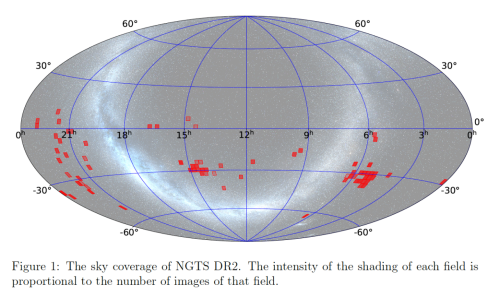The Next Generation Transit Survey (NGTS) is a ground based exoplanet survey designed to detect Neptune and super-Earth sized planets orbiting around bright stars, using the transit method. The NGTS facility consists of 12 fully-robotic 20 cm f/2.8 telescopes located at the ESO site on Paranal, Chile. Each telescope has a 2.8x2.8 deg2 field of view and is equipped with a custom filter with a bandpass of 520-890nm, which increases sensitivity to late-K and early-M stars.
Second Data Release of the Next Generation Transit Survey

This second data release (DR2) includes 72 separate fields that have been completed from the start of commissioning in September 2015, till April 2018. The data of the 24 fields already provided within DR1 have been reprocessed with an improved version of the reduction pipeline. A source catalogue down to 16th magnitude is provided, together with the light curves obtained with aperture photometry in addition to the reduced, astrometrically calibrated, stacked dithered images. More than six hundred thousand sources were monitored with a 13 second cadence, collecting almost 110 billion photometric measurements in total. The overall data volume is about 4 Terabyte.
All data are publicly accessible from the Science Portal or programmatically in a file-by-file fashion. Per-source data access is provided by the Catalogue Facility or via TAP. Detailed information is available in the accompanying release documentation.
